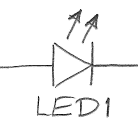
| Brandeis University | Physics 29a |
| Spring 2020 | Kevan Hashemi |
Part 1: Build the following circuit to study the behavior of a silicon diode. For D1 use the 1N914. You will find the 1N914 data sheet on the Physics 29A website. Supply X with a variable voltage source. Start with R1 = 100 kΩ.

By varying X, and occasionally switching to a lower value of R1, measure voltage, V, for current, I, in the range 10 μA to 100 mA. Plot log(I) verses V. Use the slope and intercept of this graph to determine the diode's saturation current, IS, and ideality factor, n. Note that VT = kT/q, where T is absolute temperature, k is Boltzmann's constant, and q is the magnitude of the electron charge. If the ideality factor is constant with temperature, how might you use a diode as a thermometer?
Part 2: Continue working with the circuit of Part 1. User your bench-top power supply to deliver 0 V to 5 V to X. Measure V and plot a graph of V versus X. Make sure you take several data points at any non-linear portions of the graph. Reverse the direction of D1 and plot a second graph of V versus X for the reversed diode. Explain your graphs to one of the instructors.
Part 3: A light-emitting diode (LED) is a diode with a specialized PN junction that emits light when currents passes through it in the forward direction. Red LEDs have a forward voltage drop of around 1.8 V, yellow around 2.0 V, green around 2.2 V, and blue around 2.8 V. A white LED is a blue LED with yellow phosphor on top. The figure below shows the schematic symbol for an LED.

There are various colors of LED in the LED draw. The clear ones are blue or white. All are designed to operate with 20-mA forward current. If you pass 50 mA through them, they suffer permanent damage. Design a circuit to illuminate four colors of LED at the same time with a 5-V power supply. Draw a diagram of your circuit and show it to an instructor. Build the circuit and measure the voltage across the different colors of LED. Why is the forward voltage drop of a red LED roughly 2 V? Why is it not possible to make a white LED by putting phosphor on a red LED?
Part 4: Use your function generator to make your four LEDs flash on and off. Try the triangle, sine, and square waves as a source of power for the LEDs. Explain to the instructor why these waveforms give rise to different visual effects. Re-arrange the circuit so that half the LEDs alternate flashing with the other half.